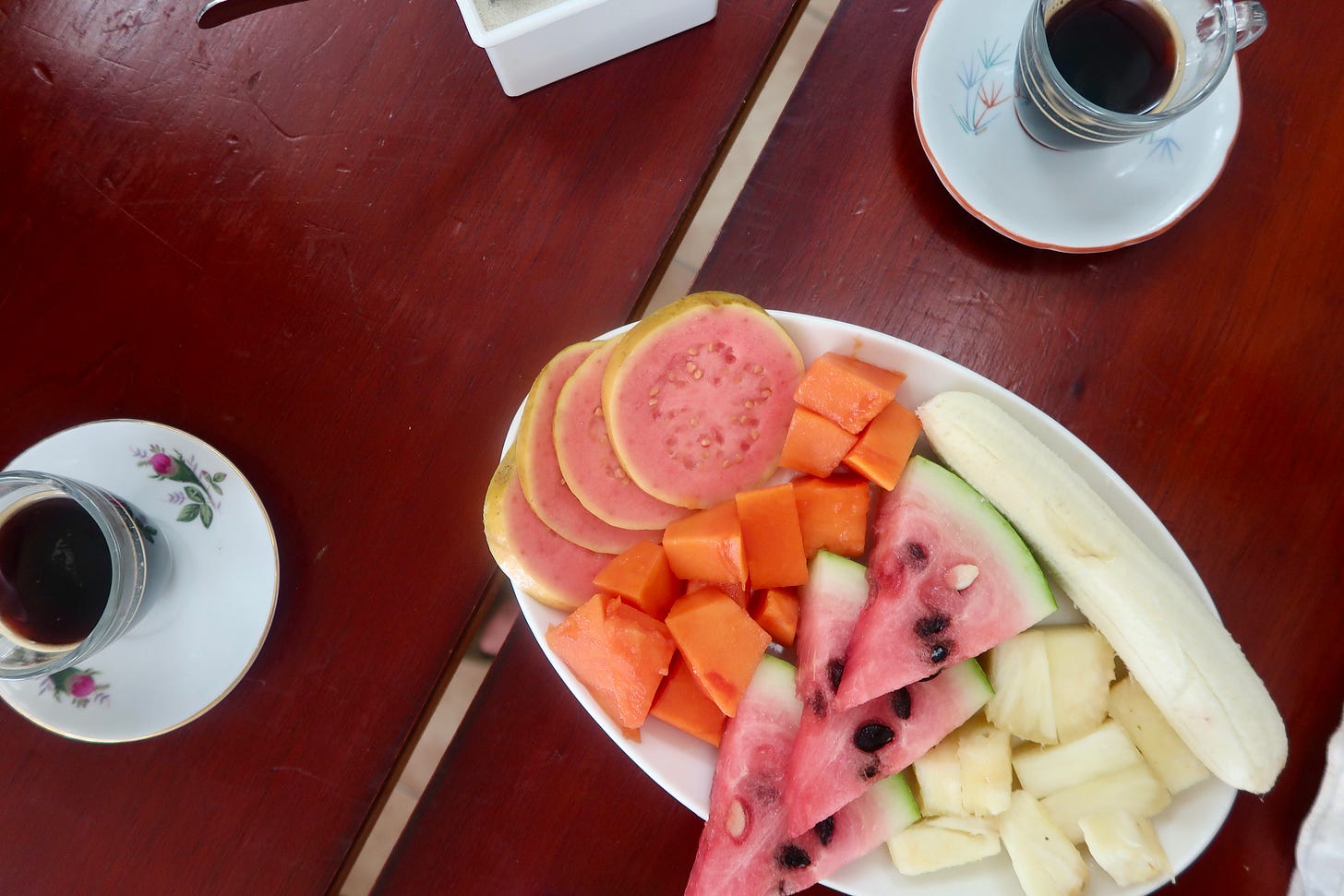Breakfast fruit plate with papaya from Cuba, December 2019.
In Ciudad Mexico, it is so dangerous to be a woman, that to take public transportation there are two designated trains: one for women and children, the other for men. Because in Mexico, 10 women on average will die per day due to gendered violence against women. A recent protest that erupted on International Women’s Day in Mexico reminded the world of this. It also reminded me how much of machismo and misogyny exists deeply seeded in the mind and body, even living across the border from Mexico. How expressions of it vary but all stem from the same root. Machismo wilts everything it touches about a woman.
Even our relationship to food.
Eunice Mendoza defines machismo in their 2009 paper for Rochester Institute of Technology: “In Latin American culture, machismo is a social behavior pattern in which the Latino male exhibits an overbearing attitude to anyone in a position he perceives as inferior to his, demanding complete subservience.”
It manifests as a need to control or have a say over how non-male people lead their lives.
Machismo assigns value in femininity by standards of beauty, sexuality, or caretaking abilities before ever seeing our humanity.
It was visible in the way the female image was depicted in novelas, magazine covers, and beauty pageants; with tiny waists, big breasts, and slim figures. In fact, last year, Mitu reported that Mexico’s newly formed ‘Gender Equality Commission’ is working to ban beauty pageants in response to the rising rates of femicide:
“The commission sees beauty pageants as contributing to gender stereotypes, machismo attitudes, and, in turn, endemic violence against women.”
I still remember meeting grown men, sometimes friends of my dad, who’d say how beautiful I’d be when I grew up, already seeing the object in me before acknowledging the human––and this was seen as normal. What I hadn’t realized yet, was that machismo culture was already defining that my value as a human was as carnal as the shape of my nose versus as infinite as the contents of my mind.
As for me, I just wanted to be seen as a human being. To speak when I wanted to, to be soft, to be funny––to prove I could do anything a man could. Who I wanted to be existed outside of sex, beauty, and duty, and I had to resist these imposed perceptions daily just to be. But this doesn’t mean I did not also fall prey to these ideas and expectations.
I was shamed for my body weight during my childhood. I’ve had an exorbitant appetite ever since I was young, and it showed––this is to be expected. But I was not overweight as a kid, a few pounds over––sure, but it wasn’t cause to worry. And yet, my dad was there to remind me of what a “mujercita” should eat like whenever I wanted a second helping of food, a second burger, another taco––policing my plate until I began doing it for him once I developed anorexia and bulimia in highschool. His encroachment and constant criticism of my body made it no longer my sanctuary, but a prison.
My body became a way to measure my worth. Seeing my mom and other women around me always on some kind of diet to lose weight only solidified the point that beauty and health equated to thinness. The price of beauty came with robbing myself of enjoying foods I loved until I could no longer divorce pleasure and pain. The burgers I once enjoyed with strawberry milkshakes, the ice creams, tacos, slices of pizza, Chinese take-out, and tortas became the enemy, something to be wary and fearful of.
Fear, stress, and anxiety––a product of my early experiences that stemmed in part from machismo and misogyny in the home––would eventually manifest inside of me as gastritis at a young age. Gastritis is usually developed from abusing alcohol, eating too much spicy food, or smoking heavily, I did none of those things. My doctor explained it developed from stress, I was twelve during my diagnosis. I had to cut out spicy, and highly-acidic foods, and eat a strict diet of white rice, boiled chicken, and lots of papaya for a while in order for my body to begin healing.
The body stores and manifests trauma in myriad ways. Mine lives in my stomach.
Like Veronica Lira Ortiz writes for Merion West, “Machismo may not kill as quickly as a gunshot, but it is a silent and insidious torture.”
So insidious, that it can come disguised in comments that feign being “helpful” or flattering. So silent that it can transform your mind and reduce your sense of self-worth down to the food we bow to eat three times a day. Killing yourself to have one-thousand less calories, lose ten more pounds, or fit into a size two––or whatever the patriarchy says is the standard of beauty or picture of “health.”
Machismo leaves its ugly mark on everything it touches, pierced deep in the mind, and seared into the gut. From skipping a meal in the name of beauty, to eating papaya to soothe a stomach irritated by trauma––whether in Mexico or long after you’ve left it.




